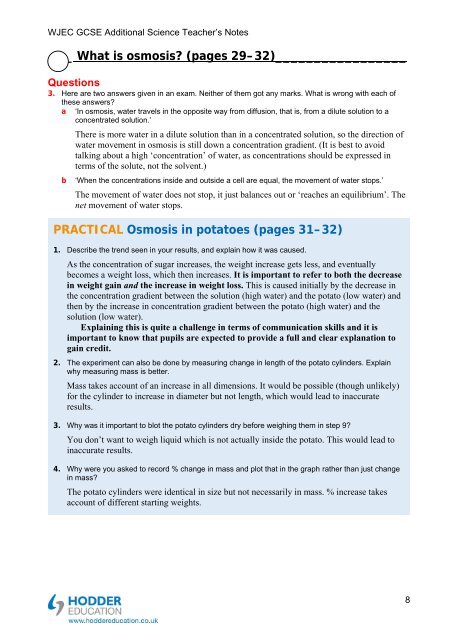Teacher's notes and answers to questions in the book - Hodder Plus ...
Teacher's notes and answers to questions in the book - Hodder Plus ...
Teacher's notes and answers to questions in the book - Hodder Plus ...
You also want an ePaper? Increase the reach of your titles
YUMPU automatically turns print PDFs into web optimized ePapers that Google loves.
WJEC GCSE Additional Science Teacher’s Notes<br />
_ What is osmosis (pages 29–32)_________________<br />
Questions<br />
3. Here are two <strong>answers</strong> given <strong>in</strong> an exam. Nei<strong>the</strong>r of <strong>the</strong>m got any marks. What is wrong with each of<br />
<strong>the</strong>se <strong>answers</strong><br />
a ‘In osmosis, water travels <strong>in</strong> <strong>the</strong> opposite way from diffusion, that is, from a dilute solution <strong>to</strong> a<br />
concentrated solution.’<br />
There is more water <strong>in</strong> a dilute solution than <strong>in</strong> a concentrated solution, so <strong>the</strong> direction of<br />
water movement <strong>in</strong> osmosis is still down a concentration gradient. (It is best <strong>to</strong> avoid<br />
talk<strong>in</strong>g about a high ‘concentration’ of water, as concentrations should be expressed <strong>in</strong><br />
terms of <strong>the</strong> solute, not <strong>the</strong> solvent.)<br />
b ‘When <strong>the</strong> concentrations <strong>in</strong>side <strong>and</strong> outside a cell are equal, <strong>the</strong> movement of water s<strong>to</strong>ps.’<br />
The movement of water does not s<strong>to</strong>p, it just balances out or ‘reaches an equilibrium’. The<br />
net movement of water s<strong>to</strong>ps.<br />
PRACTICAL Osmosis <strong>in</strong> pota<strong>to</strong>es (pages 31–32)<br />
1. Describe <strong>the</strong> trend seen <strong>in</strong> your results, <strong>and</strong> expla<strong>in</strong> how it was caused.<br />
As <strong>the</strong> concentration of sugar <strong>in</strong>creases, <strong>the</strong> weight <strong>in</strong>crease gets less, <strong>and</strong> eventually<br />
becomes a weight loss, which <strong>the</strong>n <strong>in</strong>creases. It is important <strong>to</strong> refer <strong>to</strong> both <strong>the</strong> decrease<br />
<strong>in</strong> weight ga<strong>in</strong> <strong>and</strong> <strong>the</strong> <strong>in</strong>crease <strong>in</strong> weight loss. This is caused <strong>in</strong>itially by <strong>the</strong> decrease <strong>in</strong><br />
<strong>the</strong> concentration gradient between <strong>the</strong> solution (high water) <strong>and</strong> <strong>the</strong> pota<strong>to</strong> (low water) <strong>and</strong><br />
<strong>the</strong>n by <strong>the</strong> <strong>in</strong>crease <strong>in</strong> concentration gradient between <strong>the</strong> pota<strong>to</strong> (high water) <strong>and</strong> <strong>the</strong><br />
solution (low water).<br />
Expla<strong>in</strong><strong>in</strong>g this is quite a challenge <strong>in</strong> terms of communication skills <strong>and</strong> it is<br />
important <strong>to</strong> know that pupils are expected <strong>to</strong> provide a full <strong>and</strong> clear explanation <strong>to</strong><br />
ga<strong>in</strong> credit.<br />
2. The experiment can also be done by measur<strong>in</strong>g change <strong>in</strong> length of <strong>the</strong> pota<strong>to</strong> cyl<strong>in</strong>ders. Expla<strong>in</strong><br />
why measur<strong>in</strong>g mass is better.<br />
Mass takes account of an <strong>in</strong>crease <strong>in</strong> all dimensions. It would be possible (though unlikely)<br />
for <strong>the</strong> cyl<strong>in</strong>der <strong>to</strong> <strong>in</strong>crease <strong>in</strong> diameter but not length, which would lead <strong>to</strong> <strong>in</strong>accurate<br />
results.<br />
3. Why was it important <strong>to</strong> blot <strong>the</strong> pota<strong>to</strong> cyl<strong>in</strong>ders dry before weigh<strong>in</strong>g <strong>the</strong>m <strong>in</strong> step 9<br />
You don’t want <strong>to</strong> weigh liquid which is not actually <strong>in</strong>side <strong>the</strong> pota<strong>to</strong>. This would lead <strong>to</strong><br />
<strong>in</strong>accurate results.<br />
4. Why were you asked <strong>to</strong> record % change <strong>in</strong> mass <strong>and</strong> plot that <strong>in</strong> <strong>the</strong> graph ra<strong>the</strong>r than just change<br />
<strong>in</strong> mass<br />
The pota<strong>to</strong> cyl<strong>in</strong>ders were identical <strong>in</strong> size but not necessarily <strong>in</strong> mass. % <strong>in</strong>crease takes<br />
account of different start<strong>in</strong>g weights.<br />
8

















